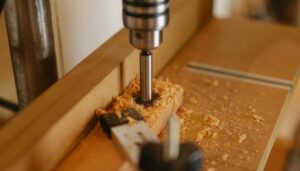Woodworking has been an essential skill and craft for thousands of years, evolving significantly from its humble beginnings. From simple hand tools to advanced modern machinery, the methods used to shape and work with wood have transformed dramatically, improving efficiency, precision, and creativity. Here’s a look at the journey from traditional hand tools to the cutting-edge machinery used in woodworking today.

1. The Early Days: Hand Tools in Woodworking
- Primitive Tools: The earliest woodworking tools were simple and rudimentary, made from stone, bone, and wood itself. Early humans used sharp stones as axes and chisels to shape wood for tools, weapons, and shelters.
- Development of Metal Tools: The discovery of metals like copper, bronze, and later iron revolutionized woodworking. Metal tools such as axes, saws, and chisels became more durable and effective, allowing for more precise work and the ability to create more complex wooden structures.
- Traditional Hand Tools: Over time, woodworking tools became more specialized.
- Saws: Hand saws of various types were used for cutting wood into different shapes and sizes.
- Planes: Woodworkers used planes to smooth and shape wood surfaces, a tool still revered for its fine control.
- Chisels and Gouges: These tools were essential for carving and joinery, allowing craftsmen to create intricate designs and strong joints.
2. The Industrial Revolution: The Birth of Machinery
- Steam Power: The Industrial Revolution in the 18th and 19th centuries brought steam power into the workshop. The steam engine allowed for the development of the first powered woodworking machines, vastly improving productivity.
- Steam-Powered Sawmills: These mills could process large quantities of timber more quickly than ever before, making wood more accessible for construction and manufacturing.
- Lathes and Planers: Powered lathes and planers allowed woodworkers to shape and smooth wood more consistently and with greater speed.
- Mass Production: As machinery improved, so did the ability to mass-produce wooden products. Factories equipped with powered saws, drills, and sanders could produce furniture, flooring, and other wooden goods on a scale previously unimaginable.
3. The Rise of Electric Power Tools
- Electricity in the Workshop: The advent of electricity in the late 19th and early 20th centuries further transformed woodworking. Electric motors powered a new generation of tools that were more reliable and efficient than their steam-powered predecessors.
- Table Saws: Electric table saws became a staple in workshops, allowing for precise, repeatable cuts.
- Electric Drills and Sanders: These tools made tasks like drilling holes and sanding surfaces faster and less labor-intensive.
- Routers: The electric router allowed woodworkers to carve detailed patterns and shapes with precision and ease.
- Portable Power Tools: The development of portable power tools, like cordless drills and circular saws, gave woodworkers unprecedented flexibility, allowing them to work on-site and tackle projects that required mobility.
4. Modern Machinery and CNC Technology
- Automation and CNC Machines: The late 20th and early 21st centuries have seen the rise of computer numerical control (CNC) machines, which have revolutionized woodworking by automating complex tasks.
- CNC Routers: These machines can carve intricate designs and shapes into wood with incredible precision, all controlled by computer software. This technology has made custom woodworking and mass production faster, more accurate, and more affordable.
- Laser Cutters and Engravers: Modern machinery now includes laser technology, which can cut and engrave wood with extreme precision, allowing for highly detailed work that was once only possible by hand.
- 3D Printing: While still emerging, 3D printing technology is beginning to make its way into woodworking, allowing for the creation of complex wooden components and tools that were previously difficult or impossible to manufacture.
- Advanced Materials and Techniques: Modern machinery also allows woodworkers to work with advanced materials, such as engineered wood products, and to employ techniques like vacuum pressing and veneer lamination, pushing the boundaries of what can be achieved with wood.
5. The Balance Between Tradition and Innovation
- Hand Tools vs. Machinery: Despite the rise of modern machinery, many woodworkers still value the use of traditional hand tools. Hand tools offer a level of control and craftsmanship that machines can’t always replicate, and they are essential for fine woodworking and restoration projects.
- Hybrid Woodworking: Many contemporary woodworkers use a hybrid approach, combining the precision and efficiency of modern machinery with the finesse and artistry of hand tools. This approach allows for both creativity and productivity, producing high-quality work that benefits from both worlds.
- Sustainability and Technology: Modern woodworking also emphasizes sustainability, with technology playing a role in optimizing the use of materials, reducing waste, and developing eco-friendly practices in woodworking.
Conclusion
The evolution from hand tools to modern machinery in woodworking reflects broader technological advancements and changing needs in society. While modern tools and machines have made woodworking faster, more efficient, and more accessible, the skill and craftsmanship involved in using traditional hand tools remain valued and respected. Whether you’re a hobbyist or a professional, understanding and integrating both traditional and modern methods can lead to a richer, more rewarding woodworking experience.


Leave A Comment